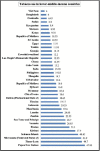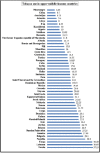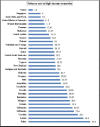Global Prevalence of Tobacco Use in Adolescents and Its Adverse Oral Health Consequences
- PMID: 32010395
- PMCID: PMC6986508
- DOI: 10.3889/oamjms.2019.542
Global Prevalence of Tobacco Use in Adolescents and Its Adverse Oral Health Consequences
Abstract
Background: Smoking is associated with various systemic conditions and contributes to a huge financial burden to economies around the world.
Aim: The study aimed to evaluate global data about the prevalence of tobacco use among male and female adolescents and to discuss smoking-related oral complications.
Methods: The prevalence data of tobacco use among adolescents (13-15 years) was retrieved from the World Health Organization (Global Health Observatory). The World Bank's statistics about gross national income (GNI) per capita were used to categorise low-income, lower-middle-income, upper-middle-income, and high-income countries. PubMed, Web of Science, Scopus, and Embase databases were searched to gather updated evidence about the adverse consequences of smoking on oral health among adolescents.
Results: The prevalence of tobacco use was 19.33%, and there were 23.29% of male and 15.35% female smoker adolescents in 133 countries (p < 0.001). The highest prevalence of tobacco use in male (24.76%) and female (19.4) adolescents was found in high-income countries. Significantly higher proportions of male adolescents were smokers than female counterparts in low-income, lower-middle-income, and upper-middle-income (p < 0.001). However, there were no statistically significant differences in tobacco use between male and female adolescents in high-income countries. Low-income countries had the lowest prevalence (14.95%) of tobacco use, while high-income countries had the highest prevalence estimates (22.08). Gingivitis (72.8%), gingival bleeding (51.2%), oral malodor or halitosis (39.6%) is common oral conditions among smoker adolescents. Smoking habit is significantly associated with dental caries, periodontal disease, hairy tongue, smoking-related melanosis, and hyperkeratosis among adolescents.
Conclusion: There was a high prevalence of tobacco use among male and female adolescents around the globe. Available evidence suggests a strong association between smoking and compromised oral health among adolescents. Globally, measures should be taken to prevent and control the menace of tobacco use to reduce systemic and oral complications.
Keywords: Adolescence; Cigarette smoking; Global prevalence; Oral health conditions; Tobacco use.
Copyright: © 2019 Muhammad Ashraf Nazir, Asim Al-Ansari, Nabeela Abbasi, Khalid Almas.
Figures





References
-
- M Wilson K, Weis E. The epidemiology and health effects of tobacco smoke exposure. Current Pediatric Reviews. 2011;7(2):76–80. https://doi.org/10.2174/157339611795735594.
-
- Raghuveer G, White DA, Hayman LL, et al. Cardiovascular consequences of childhood secondhand tobacco smoke exposure:prevailing evidence, burden, and racial and socioeconomic disparities:a scientific statement from the American Heart Association. Circulation. 2016;134(16):e336–e59. https://doi.org/10.1161/CIR.0000000000000443 PMid:27619923 PMCid:PMC5207215. - PMC - PubMed
-
- Goodchild M, Nargis N, Tursan d'Espaignet E. Global economic cost of smoking-attributable diseases. Tob Control. 2018;27(1):58–64. https://doi.org/10.1136/tobaccocontrol-2016-053305 PMid:28138063 PMCid:PMC5801657. - PMC - PubMed
-
- American Lung Association Stop smoking. Smoking Facts. 2018. [accessed on 13 November 2018]. Available from: https://www.lung.org/stop-smoking/smoking-facts/whats-in-a-cigarette.html .
-
- Goriounova NA, Mansvelder HD. Short- and long-term consequences of nicotine exposure during adolescence for prefrontal cortex neuronal network function. Cold Spring Harb Perspect Med. 2012;2(12):a012120. https://doi.org/10.1101/cshperspect.a012120 PMid:22983224 PMCid:PMC3543069. - PMC - PubMed
LinkOut - more resources
Full Text Sources
